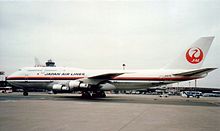Japan Airlines
| Japan Airlines 日本 航空 |
|
|---|---|
|
|
|

|
|
| IATA code : | JL |
| ICAO code : | YAL |
| Call sign : | JAPANAIR |
| Founding: | 1925 Dissolution: 1945 Re-establishment: 1951 |
| Seat: |
Shinagawa , Japan |
| Turnstile : | |
| Home airport : | Tokyo Haneda |
| Company form: | KK |
| ISIN : | JP3705200008 |
| IATA prefix code : | 131 |
| Management: |
|
| Number of employees: | 32,753 (2017) |
| Passenger volume: | 40.2 million (2017) |
| Alliance : | Oneworld Alliance |
| Frequent Flyer Program : | JAL Mileage Bank |
| Fleet size: | 175 (+ 28 orders) |
| Aims: | National and international |
| Website: | www.jal.co.jp |
Japan Airlines ( JAL for short ; Japan Air Lines until 1989 ; Japanese 日本 航空 株式会社 Nihon Kōkū Kabushiki-gaisha , 日 航 Nikkō for short ) is the second largest Japanese airline after All Nippon Airways, based in Shinagawa and based at Tokyo Haneda Airport . The company, which is listed in the Nikkei 225, is a member of the Oneworld Alliance and operates five other subsidiary airlines .
history
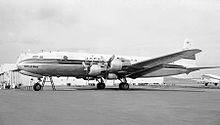
The history of Japan Airlines and its predecessors stretches from the founding in the mid-1920s to the opening of Tokyo’s Haneda Airport and the Second World War . With the Japanese surrender in the Pacific War , flight operations were banned by the Allies. It was not until 1951 that the airline was renamed Japan Air Lines Co. Ltd. newly founded and on October 10th, regional flight operations on the Tokyo-Haneda-Osaka route officially resumed. Following full privatization, the official English spelling of the company name was changed to Japan Airlines in 1989 . After the merger with Japan Air System and the establishment of several subsidiaries, the company operated from July 26, 2004 to October 1, 2006 as KK Nihon Kōkū ( English Japan Airlines Corporation ) and finally renamed itself Japan Airlines International .
In October 2005, the airline announced the airline alliance Oneworld Alliance join. This then happened in April 2007.
In summer 2009 JAL ran into economic difficulties. The Ministry of Land, Infrastructure and Transport set up a JAL Reconstruction Working Group ( JAL 再生 タ ス ク フ ォ ー ス ). On January 19, 2010, the company filed for bankruptcy with an estimated debt of 2.3 trillion yen . In the restructuring process, around 15,000 employees were to be laid off, the Boeing 747-400s were to be replaced by cheaper aircraft, 31 flight routes were to be canceled and numerous subsidiaries were to be sold. At the same time, company boss Haruka Nishimatsu announced his resignation. It was the largest bankruptcy of a company outside the financial industry in Japanese economic history.
In January 2011, JAL presented its new corporate design , which again includes the crane logo that was used from 1959 to 2002 on the aircraft's vertical stabilizer.
In 2012, following successful restructuring, the company went public. JAL replaced ANA as the most valuable airline in Japan in terms of market capitalization.
Destinations
The airports Tokyo-Haneda , Tokyo-Narita , Kansai and Osaka-Itami serve as bases, the latter is only served by domestic Japanese flights.
In German-speaking countries , Frankfurt am Main is served daily from Tokyo-Narita.
- Code sharing
Japan Airlines works with 29 codeshare partners , including some from the Oneworld Alliance and independently with Air France , Emirates , Alitalia and other non-alliance airlines.
fleet
Current fleet
As of April 2020, the Japan Airlines fleet consists of 175 aircraft with an average age of 10.5 years:
| Aircraft type | active | ordered | Remarks | Seats ( First / Business / Eco + / Eco ) |
|---|---|---|---|---|
| Airbus A350-900 | 5 | 13 | first delivery on June 13, 2019 | 369 (12/94 / - / 263) |
| Airbus A350-1000 | 13 | - open - | ||
| Boeing 737-800 | 50 | with winglets fitted | 144 (- / 12 / - / 132) 165 (- / 20 / - / 145) |
|
| Boeing 767-300 | 5 | 261 (- / 42 / - / 219) | ||
| Boeing 767-300ER | 29 | 9 equipped with winglets | 199 (- / 24 / - / 175) 227 (- / 30 / - / 197) 237 (- / 30 / - / 207) 252 (5/42 / - / 205) 261 (- / 42 / - / 219) |
|
| Boeing 777-200 | 11 | 375 (14/82 / - / 279) | ||
| Boeing 777-200ER | 11 | 236 (- / 42/40/154) 245 (- / 56/40/149) 312 (- / 28 / - / 284) |
||
| Boeing 777-300 | 4th | 500 (- / 78 / - / 422) | ||
| Boeing 777-300ER | 13 | 244 (8/49/40/147) | ||
| Boeing 787-8 | 27 | 2 | 161 (- / 38/35/88) 186 (- / 42 / - / 144) |
|
| Boeing 787-9 | 20th | 195 (- / 44/35/116) | ||
| total | 175 | 28 |
Former fleet
In the past, Japan Airlines used the following types of aircraft, among others:
| Aircraft type | number | Working time | Remarks |
|---|---|---|---|
| Airbus A300-600R | 19th | 2002-2011 | taken over by JAS |
| Beechcraft T-34 mentor | 3 | 1952-1964 | Training aircraft |
| Beechcraft Queen Air 65 | 4th | 1964-1969 | |
| Beechcraft Super H-18 | 12 | 1967-1976 | |
| Boeing 727-046 | 12 | 1965-1987 | |
| Boeing 737-200 | 9 | 1978-2002 | SWAL |
| Boeing 747-100 | 15th | 1970-2006 | |
| Boeing 747-100SR | 6th | 1973-1994 | |
| Boeing 747-100F | 1 | 1977-2000 | Cargo plane |
| Boeing 747-300 | 19th | 1983-2010 | |
| Boeing 747-400 | 29 | 1990-2011 | |
| Convair CV-880M | 9 | 1961-1970 | |
| De Havilland Canada DHC-6 Twin Otter | 4th | 1973-1994 | SWAL |
| Douglas DC-3 | ~ 20 1 |
1938 + 1939 1951 |
|
| Douglas DC-4 (E) |
1 11 |
1938 1952-1964 |
|
| Douglas DC-6A / B | 9 | 1953-1969 | |
| Douglas DC-7C (F) | 5 | 1957-1965 | |
| Douglas DC-8-32 | 4th | 1960-1974 | |
| Douglas DC-8-33 | 1 | 1961-1975 | |
| Douglas DC-8-53 | 7th | 1962-1982 | |
| Douglas DC-8-55 (AF) | 6th | 1965-1982 | |
| Douglas DC-8-61 | 20th | 1969-1987 | |
| Douglas DC-8-62 (F) | 15th | 1968-1987 | |
| Martin 2-0-2 | 5 | 1951 + 1952 | |
| McDonnell Douglas DC-10-40 | 20th | 1976-2005 | |
| McDonnell Douglas MD-11 | 10 | 1993-2004 | |
| McDonnell Douglas MD-87 | 8th | 2002-2008 | taken over by JAS |
| McDonnell Douglas MD-90 | 16 | 2002-2013 | taken over by JAS |
| Mitsubishi G3M2 | 24 | 1937-1939 | |
| Nakajima AT-2 | ~ 25 | 1936-1938 | License construction of the DC-2 |
| Nakajima AT-3 | ~ 30 | 1938-1941 | License build of the DC-3 |
| Junkers Ju 86 Z-2 | 17th | 1938 + 1939 |
Subsidiaries
Japan Airlines has a total of five subsidiaries that operate 62 aircraft as of April 2020:
| airline | active | ordered | Aircraft types |
|---|---|---|---|
| Hokkaido Air System | 4th | 1 |
ATR 42-600 Saab 340B |
| J-Air | 32 | 41 |
Embraer 170s / 190 Mitsubishi M90 |
| Japan Air Commuter | 9 | 1 |
ATR 42-600 ATR 72-600 |
| Japan Transocean Air | 12 | Boeing 737-800 | |
| Ryūkyū Air Commuter | 5 | De Havilland DHC-8-400 | |
| total | 62 | 43 |
Special paints
In contrast to the standard painting, Japan Airlines has had a wide variety of special and advertising designs on its aircraft since 1994:
- Current special paints
| Aircraft type | Aircraft registration | theme | image |
|---|---|---|---|
| Boeing 777-200ER | JA771J | oneworld |

|
| Boeing 777-300ER | JA732J |
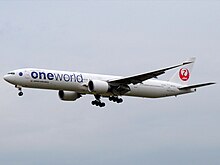
|
|
| Boeing 767-300 | JA8980 |

|
- Former special paintings (selection)
| Aircraft type | Aircraft registration number / number | theme | image |
|---|---|---|---|
| Boeing 747-100SR | JA8142 | 1st generation "JAL Dream Express" |

|
| Boeing 747-100SR / SUD | JA8170 |
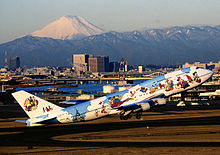
|
|
| Boeing 767-300 | JA8397-JA8399 |

|
|
| Boeing 747-400 / 400D |
JA8912 JA8905 |
2nd generation "JAL Dream Express" |
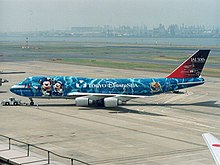
|
| Boeing 747-400D | JA8908 |

|
|
| Boeing 747-400D | JA8904 |

|
|
| Boeing 747-400D | JA8083 |

|
|
| Boeing 747-400D | JA8084 |

|
|
| Boeing 747-100 | JA8111 | "Super Resort Express" |

|
| Boeing 747-200 |
JA8104 JA8131 |
||
| Boeing 747 | 7th | "Reso'Cha": These planes flew in the JALways charter service (Reso'Cha = Resort Charter) to vacation destinations in the Pacific. This outfit stretched over the entire plane in the form of a flower pattern in three different color variants yellow, red or purple. |

|
| McDonnell Douglas DC-10-40 | 1 |

|
|
| Boeing 777-300ER | JA732J | "Samurai Blue 2006" ( Football World Cup 2006 ) |

|
| Boeing 777-200 | JA8985 | 3rd generation "JAL Dream Express" |

|
| Boeing 737-800 |
JA339J JA332J |

|
|
| Boeing 767-300ER | JA610J | "JAL Doraemon Jet" |

|
Basic data
Passengers carried
- 1996: 29.979 million (of which: 11.266 international / 17.756 national)
- 1999: 32,800 "
- 2002: 61.160 "(14.640 / 46.520)
- 2003: 58.172 "(11.745 / 46.427)
- 2004: 59.448 "(14.743 / 44.705)
- 2005: 58.035 "(14.187 / 43.848)
- 2006: 57.451 "(13.467 / 43.984)
- 2007: 55.271 "(13.367 / 41.904)
- 2008: 52.858 "(11.704 / 41.154)
- 2009: 40.144 "(8.984 / 31.160)
- 2011: 35.810 "(6.845 / 28.965)
- 2012: 37.545 "(7.525 / 30.020)
- 2013: 38.942 "(7.723 / 31.219)
- 2014: 39.438 "(7.794 / 31.644)
Freight carried
- 2002: 1,181,158 tons
- 2003: 1,189,089 "
- 2004: 1,255,722 "
- 2005: 1,221,217 "
- 2006: 1,229,293 "
- 2007: 1,213,425 "
- 2008: 1,127,992 "
- 2009: 894.907 "
Conveyed mail
- 2002: 115,209 tons
- 2003: 117,491 "
- 2004: 116.199 "
- 2005: 128,334 "
- 2006: 142,538 "
- 2007: 131,996 "
- 2008: 71,723 "
- 2009: 53,482 "
Trivia

Japan Airlines ...
- ordered the Boeing 747 on June 16, 1966 as the second company after Pan Am .
- was the first Asian airline to put a wide-body aircraft into service: the Boeing 747-146 with the aircraft registration JA8101 on April 22, 1970.
- is the largest customer of the Boeing 747 with 108 copies ordered. In addition, the airline is the only one to have ordered more than 100 jumbo jets and all of the three special variants Boeing 747-100SR, Boeing 747-300SR and Boeing 747-400D for domestic Japanese traffic bought. In addition, JAL used all versions of the 747 with the exception of the 747-SP and 747-8 .
- apart from the Douglas DC-1 and the Douglas DC-5, which never went into production, it had all Douglas civil aircraft in its fleet.
- had the largest Douglas DC-8 and DC-10 fleet outside of the United States .
- has only used three different types of aircraft on pure cargo aircraft (Douglas DC-7CF; Douglas DC-8-55F, -62F and Boeing 747-100F, -200F, -400F).
- from 1960 to 1989 equipped its jet airliners exclusively with jet engines from the manufacturer Pratt & Whitney . It was thus one of the few airlines that operated the DC-10-40 equipped with Pratt & Whitney engines instead of the best-selling DC-10-30 with General Electric engines. She ordered the first General Electric engines for her new Boeing 747-400, which came into service in 1990. Since then, both engine manufacturers have received new aircraft orders.
- opened the world's second largest maintenance hangar for wide-body aircraft and engines at Tokyo-Haneda Airport on April 5, 1983 . United Airlines operates the world's largest maintenance hangar.
- has had its own fully automatic aircraft wash facility for its wide-body jets at Tokyo Narita Airport since 1990 . A jumbo jet exterior cleaning takes 30 minutes. This system was the first in the world.
- In 1951, the company had 298 employees, 1962: 5,000, 1963: 8,000, on March 31, 1985: 20,485, March 31, 1999: 18,974.
- With an average of only 19,000–20,000 employees for 15 years, it has the most favorable passenger-kilometers / employee ratio of all major airlines.
- has been one of the world's most punctual major airlines for years, according to Flightstats.
- sold a 747 to NASA in April 1988 . After being converted to a Shuttle Carrier Aircraft , it was registered on N911NA and transported the space shuttle piggyback from the landing site in California back to the launch complex in Florida until 2011 .
Subsidiary of JAL
Japan Airlines operates several subsidiaries in the travel and aviation industries:
- Hokkaido Air System ( HAC ), a regional airline based in Chitose .
- J-Air , a regional airline based in Nagoya .
- Japan Air Commuter ( JAC ), a regional airline based in Kagoshima .
- Japan Airship Services ( JAS ) operates airships .
- Japan Transocean Air ( JTA ), a regional airline based in Naha .
- Ryūkyū Air Commuter ( RAC ), a regional airline based in Naha.
- JAL Hotels , an international hotel chain .
- JALUX (previously JAL Trading Company ) offers catering .
- JALPAK, a European travel agency chain .
- JAMCO equips aircraft and offers maintenance.
- Former subsidiaries
- JAL Express ( JEX ), a low-cost airline based in Osaka , was integrated into JAL on October 1, 2014.
- JALways (previously Japan Air Charter ) operated flights to Asia , Oceania and the USA and was integrated into JAL on December 1, 2010.
- Japan Asia Airways ( JAA ) operated flights to Taiwan and was integrated into JAL on March 31, 2008.
Color scheme of the aircraft
- 1951–1969 (1st color scheme): white fuselage, aluminum underside, red / dark blue window band, aircraft type designation on vertical tail unit (e.g. CV-880, DC 8, 727), black lettering “Japan Air Lines” in Japanese characters, from 1954 additionally in international notation.
- Early 1970 – May 1989 (2nd color scheme): hull white, underside aluminum or light gray, red / dark blue or black window band, red tsuru (crane) on the vertical tail, black lettering "JAPAN AIR LINES"
- May 1989 – November 2002 (3rd color scheme): fuselage white, underside light gray, gray fuselage band around the bow section (red at the ends), red tsuru on the vertical tail, "JAL" in black capital letters (see also both photos in this article)
- November 2002–2011 (4th color scheme): white fuselage, light gray underside, “Arc of the Sun” logo on the vertical tail, “JAL” in black capital letters. Since then, this color scheme has also applied to the subsidiaries (with the exception of Ryukyu Air Commuter), with the corresponding abbreviation of the subsidiary airline in black capital letters. (e.g. 'JAA', 'JTA', 'HAC' etc.)
- since spring 2011 (5th color scheme): hull completely white with "JAPAN AIRLINES" lettering ; again a red crane ("Tsurumaru") on the vertical tail.
Convair CV-880 of JAL in the livery from 1951 to 1969
Boeing 747-300 of JAL in the livery from 1970 to 1989
Boeing 747-400 of JAL in the livery from 1989 to 2002
Boeing 777-300ER of JAL in the livery since 2011
- Japan Airlines Cargo
- generally like Japan Airlines, but with lettering
- "JAPAN AIR LINES CARGO"
- 1989 to 1996: "JAL CARGO"
- 1996 to 2002: "JAL Super Logistics", aluminum fuselage for some aircraft
- 2002 to 2010: "JAL Cargo", hull white or aluminum.
- Southwest Air Lines, Japan Transocean Air since 1993
- 1967 to 1973: like "Japan Air Lines", but in Japanese script "Southwest Air Lines" '
- 1973 to 1978: white fuselage, red and dark blue ribbon windows, light gray underside of fuselage, orange and white SWAL logo on vertical tail unit.
- 1978 to 1993: white fuselage, wide orange window band, underside of fuselage light gray, vertical tail unit orange with wide white band, inside the white and orange SWAL logo.
- 1993 to 2002: white fuselage, light gray underside, gray band around the nose section, black lettering “JTA”, rudder unit dark red with narrow horizontal gold-colored stripes.
- since 2002: like Japan Airlines
- Ryūkyū Air Commuter
- De Havilland DHC-8-100: white fuselage with yellow-blue band, yellow wing tops
- De Havilland DHC-8-300: same as 4. Japan Airlines color scheme, but with “RAC RYUKYU AIR COMMUTER” lettering
- De Havilland DHC-8-400: same as 5. Japan Airlines color scheme, but with "RYUKYU AIR COMMUTER" lettering
- TDA / Japan Air System
- White fuselage, gray underside of fuselage, yellow-orange-red-blue band from below the row of windows and on the rudder unit, in white capital letters "TDA" or from 1988 "JAS" on the rudder unit.
- notwithstanding, received two Boeing 777 and eight MD-90 from 1996, the Rainbow design, which was available in different versions and Akira Kurosawa was designed
Incidents
- Apr. 09 , 1952 - A Martin 2-0-2 ( aircraft registration number N93043) hired by Northwest Orient Airlines (now Northwest Airlines ) crashed at Mihara Volcano during a Japanese domestic flight. All 37 people on board were killed.
- Apr. 25, 1961 - Douglas DC-8-32 JA8003 landed accident at Tokyo Haneda Airport . The machine broke apart and was severely damaged, but after nine months of restoration it was returned to Japan Airlines as the DC-8-53 (JA8008).
- Nov. 22, 1968 - A Douglas DC-8 (JA8032) hit the water about four kilometers from the runway at San Francisco Airport in thick fog . All 120 passengers and crew members survived the accident. The aircraft was later salvaged, repaired and put back into service.
- June 24, 1969 - A Convair CV-880 (JA8028) crashed on a training flight near Moses Lake, Washington, during a simulated engine failure during take-off. Three of the five people on board were killed.
- On February 24, 1970, 14-year-old Keith Sapsford, a teenage runaway, climbed into the landing gear slot of a Douglas DC-8 operated by Japan Airlines at Sydney Airport . When the plane took off to fly to Tokyo, Sapsford lost his footing. Sapsford did not survive the 60-meter fall into Botany Bay . An amateur filmmaker happened to capture the moment of the fall on picture. The photo was published in Life magazine.
- June 14, 1972 - The Douglas DC-8-53 JA8012 collided with an obstacle around 20 kilometers from Delhi Airport (India) and crashed on the ground, killing 82 of the 87 people on board and 3 on the ground.
- September 24, 1972 - The Douglas DC-8-53 JA8013 was approaching Bombay Airport when the pilots mistakenly headed for the smaller Bombay-Juhu airfield near it instead of the international airport. On landing, the machine shot over the runway, which was much too short at 1,143 m in length. There were no fatalities among the 122 occupants, but the aircraft was damaged beyond repair.
- Nov. 28, 1972 - Shortly after taking off from Sheremetyevo Airport , the Douglas DC-8-62 JA8040 suddenly lost altitude and fell to the ground. 61 people of the 76 people on board died.
- July 23, 1973 - A JAL Boeing 747-246B (JA8109) was hijacked by Arab terrorists on a flight from Amsterdam to Tokyo. A hand grenade was detonated during the flight. The damaged machine landed in Benghazi Airport (Libya). Passengers and crew were allowed to disembark there, after which the aircraft was blown up by the hijackers.
- On February 3, 1975, after a Boeing 747 of Japan Air Lines landed at Copenhagen-Kastrup Airport, 197 people had to be treated for severe food poisoning with symptoms such as vomiting, stomach cramps and severe diarrhea, 144 of them in hospital. A chef from the airline's catering company had staphylococci contaminated ham omelets on his fingers . The way the food was stored until it was served encouraged the bacteria to multiply. Thanks to a fortunate circumstance, the pilots hadn't eaten any of the meal, since, in the opinion of the investigating medical officer, they would otherwise have been unable to land the machine safely. Following the announcement of the incidents of the catering manager committed by Japan Airlines suicide . The Federal Aviation Administration changed its regulations so that two pilots assigned to the same flight should eat meals prepared by two different cooks (see also food poisoning at Japan Air Lines )
- On 13 January 1977 came at a Douglas DC-8-62AF cargo plane of Japan Airlines (JA8054) shortly after taking off from the airport Anchorage ( Alaska ) to a stall ; she fell to the ground. All five crew members of the machine died, including the heavily drunk captain (see also Japan Air Lines Cargo Flight 8054 ) .
- September 27, 1977 - Douglas DC-8-62 JA8051 was approaching Kuala Lumpur-Subang Airport (Malaysia) and was flying into a low hill 6.5 kilometers from the runway. 34 of the 79 people on board died.
- February 9, 1982 - The Douglas DC-8-61 JA8061 came off the landing path due to a pilot error (attempted extended suicide) while approaching Tokyo Haneda Airport and crashed into Tokyo Bay. 24 of the 174 occupants died (see also Japan Air Lines flight 350 ) .
- September 17, 1982 - Major hydraulic systems of the Douglas DC-8-61 JA8048 failed after taking off from Shanghai-Hongqiao Airport (China). The pilots returned to Shanghai and made an emergency landing that destroyed the plane but did not kill any of the 124 occupants.
- Aug 12, 1985 - A Boeing 747-SR46 (JA 8119) crashed while on a domestic flight from Tokyo to Osaka. The plane took off from Haneda Airport at 18:12. Due to an explosive fatigue fracture in the rear pressure bulkhead and a simultaneous failure of the important hydraulic systems, the machine crashed at 6:56 p.m. from a height of approx. 2070 meters in Mount Osutaka in Gunma Prefecture . 520 people died (all 15 crew members and 505 passengers). Only four passengers survived the accident. This is the highest death toll in civil aviation history in a single plane crash (see also Japan Air Lines Flight 123 ) .
- Jan 7, 2013 - A Boeing 787-8 battery exploded at Boston Airport and the plane caught fire. The machine was not in the air at this time, but was being prepared for flight. Nobody was hurt.
See also
Web links
- Japan Airlines website (including Japanese, English, German)
Individual evidence
- ↑ jal.com - Company Profile (English)
- ↑ finanznachrichten.de - Japan Airlines files for bankruptcy, January 19, 2010
- ↑ JAL files for bankruptcy in record failure. ¥ 2 trillion in debt; carrier awaits reconstruction. In: The Japan Times . January 19, 2010, accessed January 19, 2010 .
- ↑ Handelsblatt - GM model: Japan Airlines decides to file for bankruptcy, January 19, 2010, accessed on January 19, 2010
- ↑ a b airliners.de - JAL: Return of the crane January 19, 2011
- ↑ Risen from bankruptcy: Japan Airlines expects more profits after going public. In: Handelsblatt . November 2, 2012, accessed December 28, 2014 .
- ↑ Slightly above the issue price: Japan Airlines flies back to the stock exchange. In: Wirtschaftswoche . September 19, 2012, accessed December 28, 2014 .
- ↑ jal.co.jp - International Timetable , accessed June 26, 2016
- ↑ Japan Airlines Fleet Details and History. Retrieved April 9, 2020 .
- ↑ Airbus - Orders & deliveries , accessed on June 26, 2016
- ↑ Boeing - Orders & Deliveries , accessed on June 26, 2016
- ↑ jal.co.jp - Aircraft , accessed June 26, 2016
- ↑ flightglobal.com - JAL takes delivery of first A350 (English), accessed on July 2, 2019
- ↑ Flugrevue.de - Top 10 - Airlines with the largest Boeing 747 fleet, February 23, 2016
- ↑ Accident Report N93043, Aviation Safety Network (English) , accessed on 16 January 2016th
- ^ Accident report JA8032 , Aviation Safety Network (English), accessed on March 25, 2020.
- ↑ accident report JA8028, Aviation Safety Network (English) , accessed on 16 January 2016th
- ↑ Life Magazine, March 6, 1970, p. 76.
- ↑ accident report JA8012, Aviation Safety Network (English) , accessed on 16 January 2016th
- ^ Accident report JA8013, Aviation Safety Network (English) , accessed on December 25, 2015
- ↑ accident report JA8040, Aviation Safety Network (English) , accessed on 25 December 2015
- ^ Accident report DC-8-62 JA8054, Aviation Safety Network (English), accessed on March 4, 2019
- ^ Accident report JA8051, Aviation Safety Network (English) , accessed on January 16, 2016.
- ^ Accident report JA8048, Aviation Safety Network (English) , accessed on January 16, 2016.
- ↑ Boeing 787: Series of breakdowns keeps Dreamliner on the ground. Retrieved January 19, 2014 : “On Monday, another 787, also in Boston, caught fire. Apparently, a battery had exploded, the devices on board with power. The US transport authority NTSB stated that the fire caused serious damage to the aircraft. "





